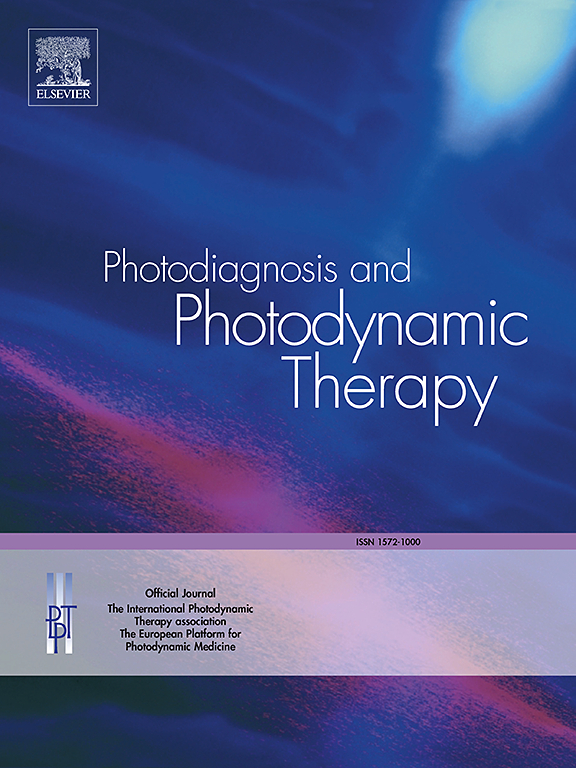Photodynamic therapy for flat warts arising on a tattoo
IF 2.6
3区 医学
Q2 ONCOLOGY
引用次数: 0
Abstract
Cutaneous warts are common benign lesions caused by human papillomavirus (HPV). While treatments such as cryotherapy, laser therapy, and electrosurgery can be effective, they may be unsuitable for warts over tattooed skin due to the risk of pigmentary alterations and scarring. Photodynamic therapy (PDT) is a non-invasive treatment that selectively targets HPV-infected keratinocytes, minimizing damage to surrounding tissue. However, no studies have specifically evaluated PDT for warts on tattooed skin. We report the case of a 25-year-old male with multiple flat warts over a long-standing tattoo on his forearm, successfully treated with three sessions of conventional PDT using 10 % aminolevulinic acid (ALA) ointment (Biosynth AG, Staad, Switzerland). Irradiation was applied with diode red light at 630 nm in wavelength (S630, Alpha Strumenti, Milan, Italy). The light source was positioned at 50 mm from the skin surface, which gave a skin irradiance of about 160 mW/cm2. The light exposure period was 8 min, resulting in a total light dose of 75 J/cm2. The procedure was well tolerated by the patient, who complained of only a mild burning sensation during light exposure. At three-month follow-up, complete wart clearance was observed, with no tattoo distortion or recurrence at one year. This case highlights the potential of PDT as a first-line treatment for warts in cosmetically sensitive areas, offering effective viral clearance while preserving tattoo integrity. Further studies are warranted to validate its efficacy in larger cohorts and establish standardized treatment protocols for tattooed skin.
光动力疗法治疗纹身上产生的扁平疣。
皮肤疣是由人乳头瘤病毒(HPV)引起的常见良性病变。虽然冷冻疗法、激光疗法和电手术等治疗方法可能有效,但由于色素改变和疤痕的风险,它们可能不适合治疗纹身皮肤上的疣。光动力疗法(PDT)是一种非侵入性治疗,选择性地针对hpv感染的角质形成细胞,最大限度地减少对周围组织的损害。然而,没有研究专门评估PDT治疗纹身皮肤上的疣。我们报告了一例25岁的男性,他的前臂上有多个扁平疣,使用10%氨基乙酰丙酸(ALA)软膏(Biosynth AG, Staad,瑞士)成功地进行了三次常规PDT治疗。采用波长630 nm的二极管红光照射(S630, Alpha Strumenti, Milan, Italy)。光源位于距离皮肤表面50 mm处,皮肤辐照度约为160 mW/cm2。光照时间为8 min,总光剂量为75 J/cm2。病人对手术的耐受性很好,他抱怨在光照下只有轻微的烧灼感。在三个月的随访中,观察到疣完全清除,一年内没有纹身变形或复发。这个病例强调了PDT作为美容敏感区域疣的一线治疗的潜力,提供有效的病毒清除,同时保持纹身的完整性。进一步的研究需要在更大的人群中验证其有效性,并为纹身皮肤建立标准化的治疗方案。
本文章由计算机程序翻译,如有差异,请以英文原文为准。
求助全文
约1分钟内获得全文
求助全文
来源期刊

Photodiagnosis and Photodynamic Therapy
ONCOLOGY-
CiteScore
5.80
自引率
24.20%
发文量
509
审稿时长
50 days
期刊介绍:
Photodiagnosis and Photodynamic Therapy is an international journal for the dissemination of scientific knowledge and clinical developments of Photodiagnosis and Photodynamic Therapy in all medical specialties. The journal publishes original articles, review articles, case presentations, "how-to-do-it" articles, Letters to the Editor, short communications and relevant images with short descriptions. All submitted material is subject to a strict peer-review process.
 求助内容:
求助内容: 应助结果提醒方式:
应助结果提醒方式:


